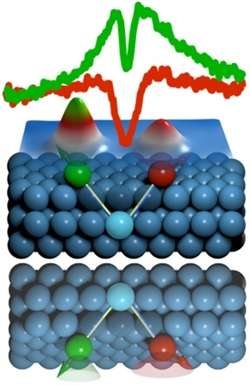Handshake of atoms—lefties or righties?

An international research team including physicists of Radboud University explored the atomistic origin of handedness of magnetization in a specific nano-structure containing as few as two iron atoms. Using a scanning tunneling microscope, they were able to controllably switch the magnetization of the iron pair back and forth from lefty to righty. This unprecedented control of the magnetization might enable a future design of stable magnetic swirls, so-called skyrmions, with tailored sizes and handednesses, which are discussed as new units for information storage and processing. Nature Communications publishes the results on February 23.
Handedness is a peculiar breaking of symmetry where a mirror image of a structure or pattern is different from its original. While the most well-known example is our own hand, there are many other materials or structures known from natural sciences which show handedness: amino acids and sugars, snail shells and swirls of magnetization, so called skyrmions, which are recently heavily investigated because of their properties' promising use as new units to store the bits of information technology. In all these structures, righties and lefties can be differentiated, which are mirror images of each other. In many of these examples, one sort of handedness is dominating. Scientists have since wondered about the possible origin of this so called homo-chirality, and it has been even proposed that evolutionary processes are responsible for handedness in some systems.
The research team from Radboud University, Hamburg University, the Forschungszentrum Jülich and the Max Planck Institute of Solid State Research in Stuttgart, now explored the source of magnetic handedness in the smallest possible units. By observing a pair of iron atoms which are laying on a surface of a platinum crystal with a scanning tunneling microscope (see Figure 1) they were able to deduce a clockwise rotation of the magnetization, proving that the pair is right-handed.
Moreover, moving the right atom by only one atomic diameter farther apart from the left atom, the rotation of the magnetization changes from clockwise to anti-clockwise, making the pair left-handed.
Together with the theory group of the Forschungszentrum Jülich, the team was able to show that the responsible mechanism for this handedness is a magnetic handshake between the two atoms mediated by the platinum substrate atoms. The researchers now hope that they can use the tip of the scanning tunneling microscope as a tool in order to build lattices of hundreds of such iron atoms, which might then host left- or right-handed skyrmions.
More information: A. A. Khajetoorians et al. Tailoring the chiral magnetic interaction between two individual atoms, Nature Communications (2016). DOI: 10.1038/ncomms10620
Journal information: Nature Communications
Provided by Radboud University



















